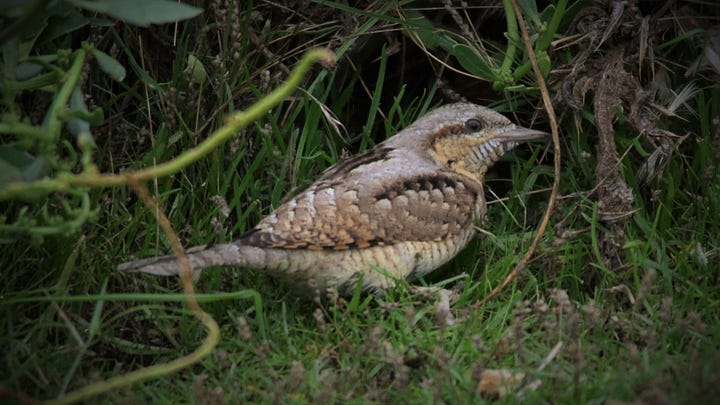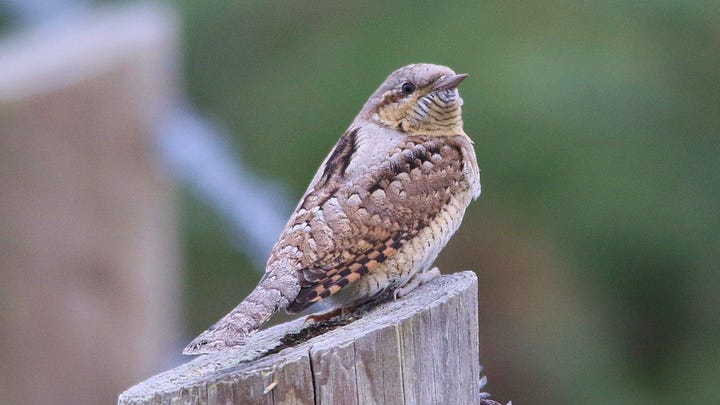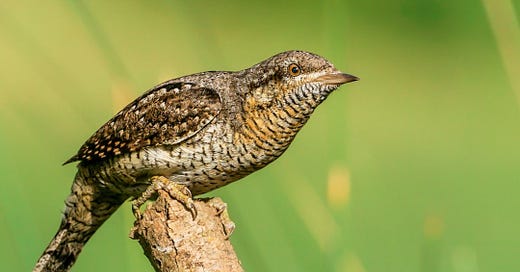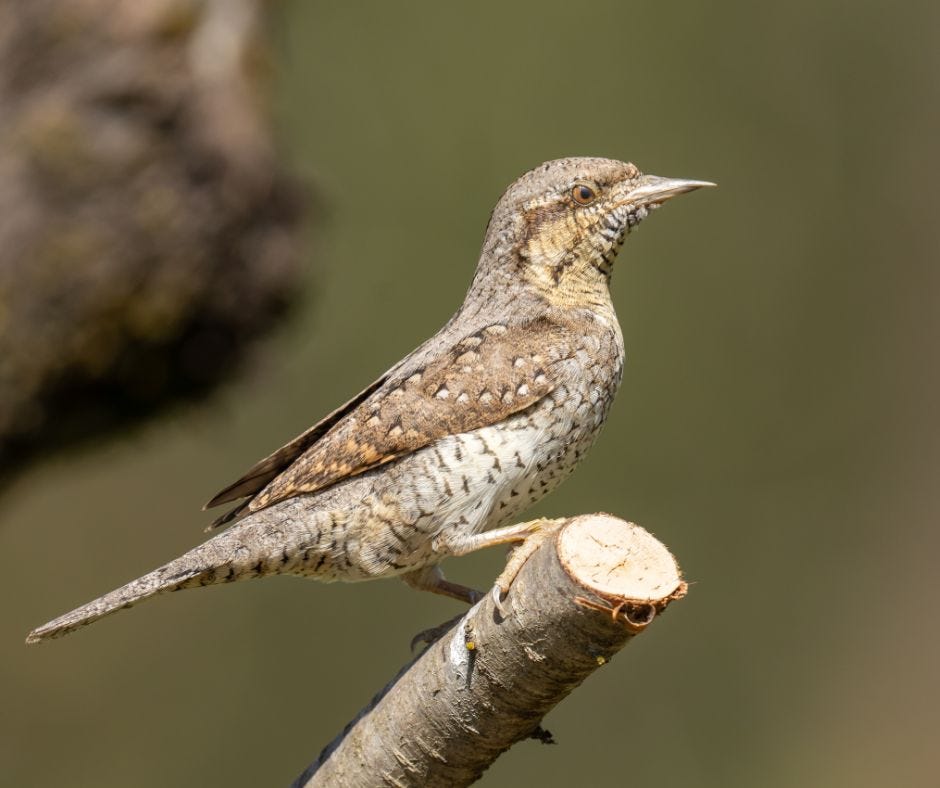A Weird Woodpecker
In Britain’s sun‑baked orchard edges, the tiny Eurasian Wryneck (Jynx torquilla) lurks like a living twig, its bark‑blotched plumage rendering it all but invisible. Yet catch that serpentine neck‑twist and low, viper‑like hiss in the dappled shade of an old apple tree, and you’re suddenly transported into a realm both ancient and enchanted.
The Wryneck’s appearance is a study in subtlety. Its upperparts are intricately barred in ashen greys, browns, and blacks, rendering it near invisible when clinging to a trunk. The underparts are light and closely speckled, with dark arrowhead markings running backwards over the breast and belly. The face is given quiet interest by a buff moustachial stripe and a faint cream supercilium. It lacks the bright red or showy characteristics of its more vociferous woodpecker cousins. In fact, were it not for its peculiar mannerisms, you would not spare it a second glance.
Freaky Folklore
But the Wryneck has a trick up its sleeve—or, rather, in its neck. When threatened at the nest, it performs a most bizarre and reptile-like display: the head twists almost 180 degrees, the neck is extended, and it emits a low, guttural hiss. To early naturalists and country folk, there was something of the sorcery about this. In fact, it's from this odd behaviour that we derive the word "jinx"—one of the old names for the bird and a reference to its supposed power to curse.
An Ant-eater
Ants and their larvae constitute most of the Wryneck's diet. It does not drum on trees or ascend trunks in search of beetles like other woodpeckers. Instead, it forages on the ground with a flicking tongue, much like an anteater in miniature. You’ll find it probing soft soil, mossy stumps, or leaf litter, usually alone or quietly paired. Its movement is deliberate, with pauses between hops, tail occasionally flicked for balance. It is a bird of silence and stillness, requiring patient observation.
Where’s the Wryneck?
Old, untended orchards, rough grasslands, and open woodland edges are ideal foraging habitat. These support the patches of bare ground and plentiful ant colonies that the Wryneck favours. Such habitats are now in short supply in modern agricultural landscapes.
While once a regular summer breeder across lowland England, with isolated sites in the East Midlands, the Wryneck began to retreat from its British breeding grounds by the mid-20th century. Breeding had all but ceased in England by the early 1970s. The most recent confirmed nestings were in Scotland in the early 2000s, but even these were exceptional. Today, the Wryneck is present in the British birdscape only as a scarce spring and autumn migrant, often surprisingly appearing at the side of fields or unexpectedly turning up in September gardens, particularly after easterly winds.


In the rest of Europe, however, it remains a widespread and generally stable breeder. Across Poland, Romania, the Baltic states, and southern Germany, Wrynecks still visit apple orchards and woodland clearings. Even the Mediterranean basin and Spain have healthy populations, and in the Alps and Carpathians, they're a regular component of the summer bird chorus. In autumn, the birds migrate south, bound for the Sahel belt of Africa, where they spend the winter in dry savannah and scrub.
Wrynecks nest in holes, but they don't excavate them. They use pre-established cavities—old woodpecker nests, decayed limbs, or even cracks in farm buildings. A single brood of seven or ten eggs is laid on the bare floor of the cavity. The parents incubate together, for slightly less than a fortnight, and the young fly in slightly less than three weeks. As with their diet, their breeding exposes them to modern land-use changes—deadwood removal, loss of old trees, and over-tidying of orchard edges have all helped to push the species into British decline.
Though the Eurasian Wryneck is not globally threatened—its total population comfortably numbers in the tens of millions—it is, in the UK context, a conservation ghost. A Scheduled 1 protection under the Wildlife and Countryside Act, it's a bird we can now possibly only catch fleetingly, as it pauses between distant breeding and wintering grounds. Efforts at restoring its foothold here have concentrated on habitat improvement: ancient orchards being maintained, insect-friendly grasslands being preferred, and nest boxes being erected in suitable areas. In Switzerland, such measures have increased resident populations. Whether the same destiny can befall in Britain is a tantalizing enigma.
A Poetic Passerine
The Wryneck has held a fascination over the human imagination for centuries. In folklore, it was an omen, a charm, a cursed bird. The bird in medieval love spells once was believed to be able to twist others' will—no wonder, perhaps, with a name that coincides with the magical "jinx." In literature, it flits through Shakespearean verse and country poetry, and in the notebooks of Victorian field naturalists, the Wryneck is an orchard and hedge bird, recorded with fond attention, shot for closer inspection frequently—an irony not lost on modern readers.
And of course, let us not forget John Clare’s poem, The Wryneck’s Nest:
That summer bird its oft-repeated note
Chirps from the dottrel ash, and in the hole
The green woodpecker made in years remote,
It makes its nest. When peeping idlers stroll
In anxious plundering moods, they by and by
The wryneck's curious eggs, as white as snow,
While squinting in the hollow tree, espy.
The sitting bird looks up with jetty eye,
And waves her head in terror to and fro,
Speckled and veined with various shades of brown;
And then a hissing noise assails the clown.
Quickly, with hasty terror in his breast,
From the tree's knotty trunk he slides adown,
And thinks the strange bird guards a serpent's nest.
- The Wryneck's Nest, John Clare Nowadays
These days, when a Wryneck appears on a windy headland or in a hidden churchyard yew, news spreads fast in local WhatsApp groups and BirdGuides alerts. Birders scramble to twitch it, knowing how rare and unpredictable these migrants have become. And when you finally see it—hopping modestly between apple roots, merging with the bark, or tilting its head with serpentine elegance—you can understand why.
The Wryneck is a ghost bird of glimpses and folklore, of fieldcraft and whispered stories. To us in the East Midlands, it's a visitor from a wilder past—subtle, sly, and strangely affecting.
Thanks for reading ‘Wryneck’!








Thanks so much for that info. The wryneck turns up in UK crosswords and now I know what it looks like 😄
I heard they're common especially in my home country, but I never saw one. And I really really want to!